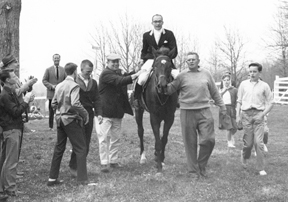A Gentleman Jock & His Gallant Foxhunter
…and how they became Hunt Cup contenders
by Margaret Worrall
In the early and mid-1960s, an ordinary little brown horse and his rider, a businessman and avid foxhunter, did something extraordinary: they challenged two of the greatest timber horses of all time, Mountain Dew and Jay Trump. In the end, Hurdy Gurdy and Kingdon Gould, Jr. would not win either a Hunt Cup or a Gold Cup, but they certainly proved their mettle in the process.
The duo’s Maryland career was launched with their win of the 1961 Howard County Cup, historically the prep race for Maryland’s big timber (these days, the Howard County Cup Races are held in the more amiable weather of May). The pair spent the next four years either just beating or just losing to these two timber giants. In the process, Hurdy Gurdy and Kingdon Gould, Jr. reinvigorated the original spirit of Maryland timber racing: amateur riders taking their foxhunters over timber fences in the spring just to see who had the fastest horse!
On this, the 50th anniversary of their first Howard County Cup victory, the members of the Howard County-Iron Bridge Hounds will dedicate a perpetual trophy to be awarded at the end of the spring racing season to the foxhunting duo who performs the best in the Maryland Steeplechasing Association’s Governor’s Cup Series. The trophy, to be called The Hurdy Gurdy, will be dedicated on March 19 at a ball hosted by HCIBH to kick off the 2011 steeplechase season.
The horse world is full of great stories of great horses, and the stories of the legendary Jay Trump and the renowned Mountain Dew have been told many times over. But there are great horses that we rarely hear about, because they had the unfortunate timing to be running against the legendary horses—horses such as Sham, a great horse who had the misfortune to run against legendary Secretariat (and whose story can be read in the newly released Sham: When Great Was Only Second Best, with photos by Maryland’s own Cappy Jackson; see equiery.com/archives for a book review).
The Equiery is pleased to chronicle the story of this great little horse and his determined foxhunter, as the duo serves as inspiration for all adult amateur riders—particularly those who, like Kingdon, only discover the sport once they are well into their adulthood!
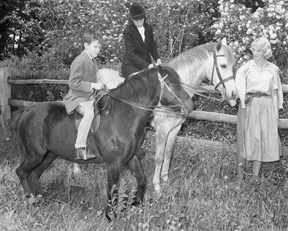
Thorne and Lydia Gould in 1959
A restless intellect. A competitive drive. A thirst for knowledge. A lust for life. A high risk tolerance. Strategic. Methodical. Athletic. A thinker, a planner, a doer.
All of these, and more, could be used to describe Kingdon Gould, Jr.
“My father is a true Renaissance man,” explains Thorne Gould, the second son of Gould’s nine children. “He’s done so many things and he plans to do so many more. Just the other day, he called me to recite a poem in Sanskrit.”
The concept of the “Renaissance man” evolved in 15th century Italian thought as the ideal human who develops one’s capacities and knowledge as fully as possible. This model embraced not only academic achievement, but physical development, social accomplishment, and expertise in the arts.
Kingdon Gould III, the eldest son, applied the term in regard to his father this way: “Because of Dad’s interests, we got to do a lot of things and had lots of adventures. It was a great way to live because our parents were always involved and they didn’t make it easy on us. No matter what we were doing, we learned that we had to be good sports and we had to play well if we wanted to beat our parents.
“I remember that one year we played in the father–son tennis championship and were out in the first round, but we were back there the next year, determined to do better. It was my father’s philosophy that we get the most out of life if we put more into it.”
And no one puts more into life than Kingdon Gould, Jr. His resume lists his “recreational interests” as backpacking/mountain climbing, riding, swimming, fly fishing, tennis, squash, golf, skiing, chess, and sailing. His grandchildren call him “Scacchi,” (Italian for chess) for obvious reasons. He also speaks five languages with some fluency.
Born in 1924, Gould was raised in New York City, the only son and third child of Kingdon Gould, Sr. and his wife Annuziata Lucci. Kingdon, Sr., the grandson of New York financier and railroad magnate Jay Gould, was an avid sportsman who grew up playing polo with his brothers George and Jay (sometimes on bicycles using a croquet ball). Kingdon, Sr. was rated a five-goal player by the age of 16, as well as a champion in court tennis, which he sometimes elected to play on roller skates (always helpful to find tennis partners). In addition he was a linguist, calligrapher, amateur archeologist, historian, and mining engineer.
Annunziata Gould’s wide field of interests made her an equal role model for her children. She first met Kingdon, Sr. when the Goulds hired her to teach Italian to the family.
“My grandmother was a lovely lady,” remembered Thorne. “She appreciated all forms of art and literature and loved the outdoors. She herself was an artist. I have some of her oil paintings and I treasure them.”
Kingdon, Jr. excelled as the quarterback of the football team at Millbrook School, and although he insists that he was not an outstanding scholar, he was accepted to Yale University.
World War II was in full swing by that time and Kingdon, Jr. left in his freshman year in 1942 to enlist. A 1990 article by Rick Greenberg in Regardie’s Magazine quoted Kingdon’s sister Edith Martin, “I remember him saying, ‘I can’t sit here concentrating on Elizabethan literature while those guys are getting slaughtered over there and our country is in danger.’ ”
Kingdon became part of the Army’s 36th Cavalry Reconnaissance Squadron Mechanized and was deployed to Europe. On November 23, 1944, these soldiers crossed the English Channel to engage in the Battle of the Bulge. Kingdon was twice decorated for bravery, awarded two Purple Hearts and two Silver Stars.

Mary and Kingdon Gould, Jr. at the 2004 Howard County Race Meet
Following the war, Kingdon returned to his studies at Yale and graduated Phi Beta Kappa in 1948. During that time he also met and married the beautiful Mary Bunce Thorne from New Hampshire, and today they have nine children: Lydia, Kingdon III, Thorne, Frank, Candida, Caleb, Melissa, Annunziata, and Thalia, plus 28 grandchildren and thirteen great-grandchildren.
Yale Law School followed the undergraduate studies. Upon graduation in 1951, Kingdon joined his brother-in-law’s law firm in Washington, DC, and moved his young family south.
Kingdon and Mary first lived with his mother in Georgetown while they looked for a place of their own. Mary loved the country and the rural lifestyle. Kingdon was not opposed to the idea of a farm, but he didn’t want to live too far from his office.
“We were very practical about the choice,” Kingdon remembered. “We took a compass—you know, one of those pointy things that we used to use in school—and drew a circle within 25 miles of The White House. We looked at places in both Virginia and Maryland. Finally we decided on this one, Overlook [in Laurel], which is 24.6 miles from The White House. We moved here in 1952 and never left.”
“Another selling point was that the house has eleven bedrooms,” added Mary, with a laugh, “and we needed them all.”
Known principally as a developer, Kingdon has played a part in everything from a coal company in Missouri to an alfalfa processing plant in Howard County. He was also the director and principal in Parking Management, Inc. in Washington, DC, as well as the incorporator and director of several banks from Laurel to New Hampshire, to mention only a few endeavors. And his list of public service and civic projects is just as long.
One of Kingdon’s major ongoing projects is Konterra. As chair and principal in Laurel Sand and Gravel since the 1980s, Gould, along with family members, is working to turn the property into a town center, a “mini city” where the new Inter-County Connector joins I-95, incorporating retail, residential, offices, and other mixed uses.
“Kingdon is a visionary,” said Forrest Kelly, Gould’s great-nephew who works at Konterra. “But it doesn’t end there. He expects to get things done.”
Kingdon III, who as an adult is involved in several of the family businesses, considers his father’s commercial efforts another form of the “joy of competing.”
Horses, Hunting & Family
In 1955, not long after moving to Overlook, Mary and Kingdon joined the Howard County Hunt Club. The club was not Kingdon’s first experience with horses, but it kindled his first serious pursuit of riding, foxhunting, and racing over jumps.
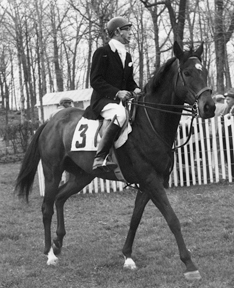
“Hurdy Gurdy was my hunter. That was the main thing. I hunted him and then if things went well, I thought of racing. It was most important to me to be out with hounds and my family.” – Kingdon Gould, Jr.
“I always rode, but I never really knew what I was doing,” Kingdon explained. “My father was a fine horseman and in the summers in the Catskills we would rent horses from the State Police. My sisters and my mother rode in New York City, but not me.
“Moreover, one of the reasons we bought Overlook is that horses were important to Mary all her life.”
“Well, we all knew how to ride. We just did,” Mary exclaimed firmly. “We got ponies for the children and joined the club and that was it.”
“Mother was the great mover on the horses,” Thorne concurred. “As kids we rode at our grandmother’s place in New Hampshire in the summers. I remember a Shetland pony named Palm Sunday that we took from Maryland to New Hampshire in the back of the station wagon. And Mother hired a great teacher, Mrs. Zimmerman, who came to the farm and taught all of us.
“This was a fantastic time to grow up. Times were simple and it was really country back then. As a 12-year-old, I could walk with my brothers or sisters to Laurel, a small country village, and no one worried about us. In the country we learned how to entertain ourselves.”
Kingdon and Mary became avid foxhunters, going out as often as possible. Hounds met several times over the years at Overlook and the Howard County races were held on the Overlook grounds in 1959. The Goulds’ eldest daughter, Lydia, participated in the races that year on her horse Liage and finished third.
“Mary had a lovely horse, Babe of War, by Man O’ War,” Kingdon reminisced. “Often she would get our horses ready and drive them to the meet, and I would come directly from the office. Mary was also a major part of a horse show at Doughoregan Manor to benefit the Visiting Nurses Association. Mary was very involved with this local group of volunteers who traveled to the schools and tested the school children’s hearing and eyesight, and generally saw to their well-being.”
Gets The Bug
Early upon their arrival in Maryland, the Goulds were invited to a lunch up in Baltimore County at the home of some friends. Once there, the friends said, “Come on, let’s go watch the race!” Little did Kingdon expect what would happen next.
The race the Goulds walked over to watch was nothing other than the Maryland Hunt Cup: four miles, 22 vertical timber fences up to 4’10”, the most grueling jump race in the world. “‘Wow, I said. Wow, that’s amazing,’ ” Kingdon declared. “I’d never seen anything like that!”
Not surprisingly, Kingdon made up his mind then and there that he was going to ride in the Hunt Cup. As is his nature, he came up with a strategy, and the first order of business was to find a foxhunter who had the potential to run over timber fences. He found that potential in a compact brown gelding named Hurdy Gurdy, by Alquest out of Kid Whoop.
Hurdy Gurdy, the Handy Foxhunter
“I went to try this horse at Ridgely White’s in Virginia,” Kingdon related in a wry tone of voice. “By mistake, I jumped him into a pigpen. I’m not sure how this happened, but it also happened to me in that Howard County Old-Fashioned at Oakdale. My route took me through another pigpen. I would have won, too, but I lost my stirrup and Sam Pfefferkorn beat me!
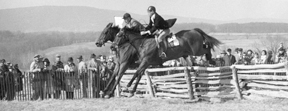
Kingdon and Hurdy Gurdy on their way to winning the Piedmont in 1961
“In any case, I bought Hurdy Gurdy in 1959 and brought him home. Soon after that he had a bad accident in the trailer. He got his hoof caught under the center panel and seriously cut the coronet band,” Kingdon continued. “It took a long time to heal and he always retained a curious hoof. My friend Tommy Maher gets a lot of credit because he suggested I use something called ‘Mighty Oil’ and the injury finally healed over.
“Hurdy Gurdy was my hunter. That was the main thing. I hunted him and then if things went well, I thought of racing. It was most important to me to be out with hounds and my family.”
After going out sixteen times with Howard County that fall, Kingdon and Hurdy Gurdy were ready to try racing in 1960. The pair started at Casanova and finished fifth. At Howard County they finished second but were awarded first place after Marilyn Reid on Bencouer cut a flag and was disqualified. (This was the first year that Howard County ran over a fixed, flagged course. On the same program, Thorne Gould is listed as riding Moonlight in the Pony Flat Race.)
The pair continued at Orange County in Virginia where they were third in the George L. Ohrstrom Memorial for owner/riders, after having one refusal. Two weeks later they came back at the My Lady’s Manor Races in the John Rush Streett Memorial for nonwinners of two races. Six went to the start, but only two finished. Frank Bonsal on Sagahash was the winner, with Hurdy Gurdy second.
“Hurdy Gurdy had been within striking distance until the fifteenth fence, but on this jump he ran out,” wrote Snowden Carter in The Maryland Horse.
The final 1960 attempt was the Western Run Plate, a maiden race at the Grand National Steeplechase in Butler. Kingdon pulled up after the sixth fence.
“I’d had some problems that year, and I wasn’t sure of Hurdy Gurdy’s capabilities, “ said Kingdon “I saw Mikey Smithwick and asked him if he would swing by after the races at Laurel where he was running some horses.
“Mikey came out and got on Hurdy in his business suit, jumped him over a couple of fences, and said, ‘He’s got all the jump you need.’ So, I felt encouraged to go on with him.”

The 1962 Maryland Hunt Cup (photo printed in The Baltimore Sun): (l to r) Janon Fisher riding his own Mountain Dew, George Weymouth’s Eastcor, John K. Jenney’s Ba-sic and Kingdon Gould riding his own Hurdy Gurdy
1961: Hurdy Hits His Stride
After foxhunting twelve times in the fall of 1960, Hurdy Gurdy started the spring season with a fifth at Rappahannock with Kingdon in the irons. Mary, Kingdon and the family were unexpectedly detained out of town the following weekend, so Kingdon asked a local young man, Richard Zimmerman, to take his place at Blue Ridge, where Hurdy Gurdy proceeded to break his maiden in a novice race, the Sandy Baldwin Memorial. Kingdon returned to be the winning rider at Warrenton and Piedmont.
Then it was back home to Maryland, back to his own race, the Howard County Hunt Cup. From The Baltimore Sun, Sunday April 2, 1961 (writer Albert Fischer):
Kingdon Gould, who also doubles as a member of the Hunt committee, found time off from his duties yesterday to guide his mount Hurdy Gurdy to a going-away triumph in the featured Howard County Hunt Cup.
The Laurel, Md. rider kept pace with his rivals most of the way, finally taking the lead at the eleventh jump of the sixteen jump course.
He increased his lead the rest of the way, cruising to a ten-length triumph at the finish.
Col. Percy Hayden’s Pat. A B, with Jack Griswold handling the reins, took the runner-up spot [followed by] Marilyn Reid on her Ben Cover. [Ben Cover is listed in the race program as Bencouer, but all press reports refer to him as Ben Cover. –ed]
“I just let him stay close,” said Gould. “You know, those two [Griswold and Miss Reid] were really knocking each other, neither one would give any quarter. I caught Griswold at the eleventh and I think that when we took the lead, I cut him off,” Gould concluded.
Hurdy Gurdy finished with a 6.50 clocking for the 3.5 mile course, best time of the day.
In the Washington Star, Anne Christmas wrote:
The old line about youth being served went by the boards today as Kingdon Gould, a Washington businessman, outgamed young talented riders…
Mounted on his own Hurdy Gurdy, Gould rode a carefully judged race for three and a half miles over 17 timber fences to win the featured amateur event by 10 lengths…
Mrs. Reid, who set an early pace, said her big Argentine-bred horse [Ben Cover] was far off his customary form and blamed a bruised foot suffered last week in a Virginia race. Ben Cover finished first in this race last year, but was disqualified for cutting a flag.
Gould, who was riding against competitors 15 to 20 years his junior, has had a great season with his eight-year-old thoroughbred.
Also running that day in the 1961 Howard County Races, in the Alda Clark Challenge Plate, was the horse that would prove to be one of Hurdy Gurdy’s two Hunt Cup nemeses: Mountain Dew.
Next the pair won at Potomac (held earlier in the season in those days), but Kingdon lost his lead pad during the race and was thus disqualified.
With the point-to-points (unsanctioned steeplechase races, not run under any national rules) duly conquered, it was onto “the big timber races” (run under national rules) for Kingdon and Hurdy Gurdy.
They finished second by a head in the My Lady’s Manor to Bally Guy, ridden by Jamie Hruska and owned by Kingdon’s friend John Schapiro, owner of the Laurel Race Course. “They came down to the wire as a team,” noted Baltimore Sun reporter Albert Fischer.
A week later they were back in Virginia for the Middleburg Invitational, where Hurdy Gurdy prevailed by two lengths over six-time United States Olympic rider Frank Chapot on Phalene. Alexander Mackay-Smith, editor of The Chronicle of the Horse, wrote to Kingdon: “That finish you put on in the Middleburg Invitational race was one of the most exciting I have ever seen in a timber race.”
Two weeks later in the Virginia Gold Cup, Hurdy Gurdy “graduated into the big time,” as Kingdon put it. They closed with a rush to be second by three lengths to Mainstay, ridden by the champion professional jockey Joe Aitcheson, and fifteen lengths ahead of Simple Sampson, ridden by yet another champion professional, Paddy Smithwick. Under Crompton “Tommy” Smith, Jr., Simple Sampson had won the Maryland Hunt Cup a week previous. Hurdy Gurdy finished the season as the leading point-to-point horse of the year, with the award presented at the United Hunts Racing Association dinner at the Plaza Hotel in New York.
1962: “Up, Hurdy!”
1961 may have been the year that launched Hurdy Gurdy’s career and proved that he was a contender, but 1962 would kick up Hurdy Gurdy’s competition another level entirely.
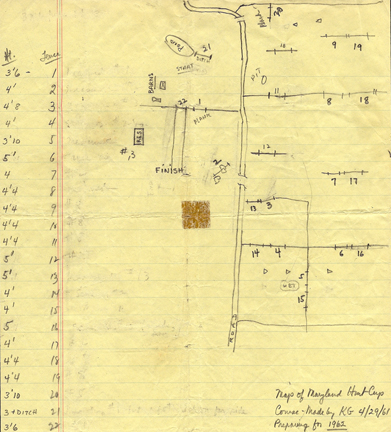
Kingdon Gould began planning how he was going to ride the 1962 Hunt Cup at the 1961 meet when he drew this course map, complete with jump descriptions and footing notes.
With only two years of jump racing under his distinctive Graham of Montrose tartan green silks and less than ten years foxhunting, Kingdon decided that he and his horse were ready for the Maryland Hunt Cup: four miles over the stiffest timber fences America has to offer. Need it be mentioned that Gould was also 38 years old and riding against some of the best jockeys ever to compete in this sport: Maryland Hunt Cup winners Mikey Smithwick, Crompton Smith, Janon Fisher III and Frank Bonsal; professionals Paddy Smithwick and Joe Aitcheson; Olympians Frank Chapot and Kathy Kusner. And Hurdy Gurdy, as good as he looked at the point-to-points, was being asked to face two of the sport’s epic competitors: Mountain Dew and Jay Trump. Kingdon Gould has never done anything by halves.
Hurdy Gurdy started the 1962 season at the Virginia point-to-points as he had the year before. Once again he pummeled his competition with victories at Casanova, Rappahannock, and Warrenton. At home he suffered his first loss in a close race in the Howard County Cup.
Next came My Lady’s Manor, where Hurdy Gurdy surprised everyone with a come-from-behind charge to beat the favorite, Janon Fisher’s Mountain Dew, by only one length.
“Gould, Howard County horseman and attorney, moved his mount after the last jump as the course curved uphill to the stretch,” reported Eleanor Taylor for the Baltimore News-American. “Before that Hurdy Gurdy hadn’t had a call as the lead seesawed between Scandanus and Chestnut Chief. Mountain Dew, ridden by Janon Fisher III, was second by a length and Scandanus, owned and ridden by Douglas Worrall, was third.”
Gould and Hurdy Gurdy were now set up perfectly for their first Maryland Hunt Cup trip two weeks later, a race for which Kingdon had been preparing ever since he first saw the race only a few years earlier. Ever the strategist, ever the planner, be it a compass with which to draw a 25 mile circle around White House or a vision in the 1950s for the Inter-County Connector that would not come to fruition until the 21st century, it is safe to say that Kingdon does not embark on any venture without thorough forethought and a plan, and the Hunt Cup was no different. In his pocket that day was his hand-drawn course map on yellow legal paper that he created while walking the Hunt Cup course in 1961, complete with jump descriptions and footing notes.
The race started well with Mountain Dew held behind, letting three others set the pace. Hurdy Gurdy stayed with Mountain Dew. Mountain Dew drove down the stretch to catch the leaders at the wire, and Hurdy Gurdy, in a similar final thrust, finished third.
In their first Maryland Hunt Cup, where it is a mark of great pride just to finish, Hurdy Gurdy and Kingdon Gould had shown themselves worthy. The best was yet to come.
1963: When Great is Not Good Enough
The next year saw Gould and Hurdy Gurdy gearing up again in Virginia with a win at Blue Ridge (“Hurdy Gurdy landed over the 14th and went away as if the flag had just been dropped, passing the two leaders,” reported The Chronicle of the Horse) and another at Warrenton. They didn’t run at Howard County that spring, but took on Mountain Dew again at the Manor. This time, however, they were less successful, finishing in third place.
Nevertheless, the scene was set for a second attempt at the Maryland Hunt Cup. And what was the competition? Mountain Dew and Jay Trump (first and second respectively in the Grand National the week prior), each of which would finish their careers with three Maryland Hunt Cup wins each.
“One of the nicest things that day happened in the paddock,” Kingdon remembered. “Mr. Fisher [trainer of Mountain Dew] came up to me, put his hand on my shoulder, and said, ‘If it’s not us, I hope it’s you.’ That’s the kind of spirit there was in these races.”
John Rossell in The Maryland Hunt Cup, Past and Present, having described two fallers, went on to depict the finish:
This left Mountain Dew, Jay Trump, and Hurdy Gurdy to fight it out, and quite a fight they had! Mountain Dew was still showing the way along the woods on the second turn of the course but Crompton Smith by now had Jay Trump under somewhat better control and he was once more putting on one of those beautifully timed rides for which he was well known. At the nineteenth fence Mountain Dew bore out, Jay Trump jumped on the inside and went to the front. He did not yet have the race won, however, for Mountain Dew was still pressing him hard and Hurdy Gurdy was close behind. Jay Trump and Mountain Dew jumped the last fence together and for a brief moment it appeared that the finish drive which Mountain Dew had always shown would prevail. It was not to be; Jay Trump outran him in the stretch to win by four lengths with Hurdy Gurdy another ten lengths back. The clock said 8:42 1/5, a course record.
Amazingly, the intrepid Kingdon Gould wheeled Hurdy Gurdy back the next Saturday to finish second to Mrs. June McKnight’s Hill Tie, ridden by Paddy Smithwick, in the four-mile Virginia Gold Cup!
1964/1965: The Gallant Campaigner
Hurdy Gurdy seemed to show the consequences of his age in the next two years. In 1964 he had a slow start to the season, or as Rossell wrote in his lead-up to the Maryland Hunt Cup of that year, “Hurdy Gurdy had shown very poor form in earlier races.”
Although he did triumph over Mountain Dew in the 1964 Howard County Cup, Hurdy Gurdy was fifth and last at My Lady’s Manor, and fourth and last at the next week’s Grand National.
Finally, over a soft Maryland Hunt Cup course, the gallant campaigner finished fifth and last behind Jay Trump and Mountain Dew, but even that would be a record others might envy.
In 1965 Gould and Hurdy Gurdy finished well behind Mountain Dew and Scandanus at Howard County, but gained some steam in the Manor, coming second by two lengths to Sea Master, ridden by Paddy Neilson. With this improvement, Kingdon decided to take his horse to the Grand National. They fell at the seventeenth fence.
“I caused Hurdy to fall,” Kingdon criticized even 46 years later. “Frank Bonsal and I got far behind Mountain Dew and Scandanus for some reason, so we decided to have a race between the two of us. Hurdy and I fell over the second last and I broke my wrist.”
Not one to give up, and despite having a broken wrist, the two started in the Maryland Hunt Cup the next week. Hurdy Gurdy refused the first fence and ended their day.
“Hurdy Gurdy was such a special horse,” Kingdon said. “We even thought about going to the English Grand National. Mary and I actually went over to look at the course. It was some kind of a rugged course. But it was too complicated to do all the traveling and the qualifiers.
“Hurdy Gurdy was my friend. We worked it out. He took care of me and I took care of him. We had a wonderful time,” he concluded thoughtfully.
After Hurdy Gurdy
Gould looked for some other horses to race and he continued to hunt regularly with that idea in mind. There was Talk A Walk, Big Stoop, and Bum Voyage, ridden in some point-to-points by his middle daughter. His offspring just didn’t have his passion for racing, although most of the family foxhunt.
“I did enjoy going to the races with Dad and Hurdy Gurdy,” Kingdon III added. “I helped with the grooming, and I loved walking the Maryland Hunt Cup and other courses with Dad. They look different close up. We would plot out which panel to jump, check the footing, and talk about where to be at a certain point in the race. Of course, it didn’t always work out that way. But I never wanted to race myself.”
Kingdon never bred his own horses either, although he tells a funny story about ending up with a friend’s in-foal mare one winter.
“I said I’d keep her for him and somehow the owner never came to get her back,” he said. “We named the foal Hokey Dokey and she actually won three flat races, but we had no real involvement. That was the thing with Hurdy Gurdy; we did it all ourselves. It was satisfying.”
“Dad has never been bored in his life,” inserted Thorne. “He is cramming every minute as full as he can, but only if he can be a participant. He’s not a spectator type.”
The Good Horse & The Gentleman Jock
Jay Griswold was riding races at that time on his father’s Dollram and others.
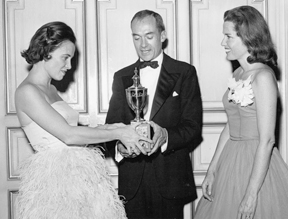
Mrs. R. Ohrstrom (left) presenting Kingdon Gould with the Virginia Point-to-Point Gentleman Foxhunter of the Year trophy, with Mary Gould on right
“That goes back, but I remember the 1962 Maryland Hunt Cup. My horse, Dollram, wasn’t going well approaching the seventeenth, but I didn’t want Kingdon to pass me. I tried to intimidate him by screaming all sorts of things.
“After the race Kingdon came up and apologized to me. I told him it was all my fault; I felt terrible. He and I still laugh about it to this day. I was just a hotshot kid, and we thought he was an old guy. But he was always very nice and a real gentleman.
“You know, when Kingdon approached each fence on Hurdy Gurdy, he would say, ‘Up, Hurdy’” and up he went! I remember it like it was yesterday,” said Jay Griswold.
“I remember the first time I met Kingdon,” added Doug Worrall, who likewise rode timber races in the 1960s. “It was some Virginia race and he seemed to be having some difficulty with his gear and getting his horse tacked up. I volunteered to help and we’ve been friends ever since.
“He’s one of the nicest people you could ever meet, with a helluva nice horse. That horse could jump anything. Kingdon was very competitive, but always unassuming and friendly, even to those of us who were just young bucks at the time.”
The Goulds took a hiatus from racing for a while. Perhaps other more important things affected their lives. Kingdon was appointed the U.S. Ambassador to Luxembourg from 1969–1972 and then U.S. Ambassador to the Netherlands from 1973–1976. While abroad, he and Mary and their daughters hunted in France and Belgium.
Will There Ever Be Another Hunt Cup for The Goulds?
As time moves on, today there’s another timber horse in the family by the name of Comanche Station.
“I purchased this horse from Joe Davies. His stepfather John Schapiro was a good friend of mine,” Kingdon said.
Davies trained Comanche Station for the Goulds in 2008 and notched a win over timber at Howard County, a second at Elkridge-Harford, and a third in the heavyweight timber at the Grand National.
The next year the Goulds trained the horse themselves at Overlook. In his first start at Blue Ridge, neighbor Caitlyn Stoddard got the chance to ride Comanche Station in her first race.
“I was helping out at the farm, exercising Talk A Call, Kingdon’s hunter,” Stoddard related. “The Goulds took me to watch the Maryland Hunt Cup and Kingdon asked me if I would like to do something like that.
“Kingdon knew I didn’t have a clue what I was doing, but he didn’t think that was important. Comanche Station was one of the classiest horses I’ve ever ridden and he took care of me.”
In one start in 2009 the pair finished second in the lady’s race at Blue Ridge. As luck would have it, however, the horse came up with an injury.
When he recovered for 2010, Comanche Station went back to Monkton to trainer Todd Wyatt. The horse was third at Plumsted, and then broke his maiden at the Willowdale meet, both in Pennsylvania. That autumn, he was third at Morven Park in Virginia and a good second to Patriot’s Path in the Pennsylvania Hunt Cup.
“The Pennsylvania Hunt Cup was definitely Comanche Station’s best race. He gained a lot of confidence,” Wyatt assessed. “He’s pleasant to be around and you can take him anywhere on any ground. We’re hoping for good things this year.”
And perhaps there will be another Gould family member in the Maryland Hunt Cup one day. Kingdon’s great-nephew Forrest Kelly, who also hunts with Howard County-Iron Bridge, has just bought his first Thoroughbred with an eye on some races this spring.
“We’ll see what happens. I love this sport,” Kelly said. “For me it’s an adrenaline high like no other, but there’s also the communication with the horse. I’ve driven motor bikes and snowmobiles, but nothing compares with this.”
Sound familiar?
©TheEquiery2011



